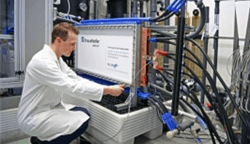Redox Flow Battery Delivers 25 kW
on

When electricity is generated from intermittent sources of energy, energy storage devices are necessary to buffer electrical power fluctuations. One option is redox flow batteries, which store electrical energy in liquid electrolytes that flow through the battery into holding tanks. These electrolytes can later be circulated back through the battery to generate electricity.
Redox flow batteries offer several advantages: they are cost-effective, robust, durable, and can be customized. The most common kind of redox flow battery uses vanadium, which is charged and discharged in small reaction chambers. Several reaction chambers are arranged in stacks, like the cells of a battery, to increases the total power.
Researchers at the Fraunhofer Institute for Environmental, Safety and Energy Technology recently developed a redox flow battery with a capacity of 25 kW. The new battery has a cell size of 0.5 square meters, eight times as large as previous systems with cells measuring 1/16 square meter, the size of a standard A4 sheet of paper. The prototype stack has an efficiency of up to 80 percent and can handle up to 500 A of current. Battery development started with testing new membrane materials and researching battery management and battery design. Flow simulations were used to optimize the cell structure. This was followed by a complete redesign of the battery.



Discussion (0 comments)